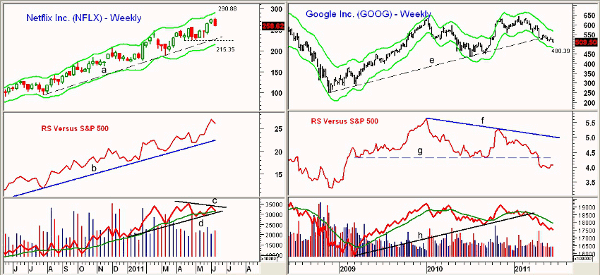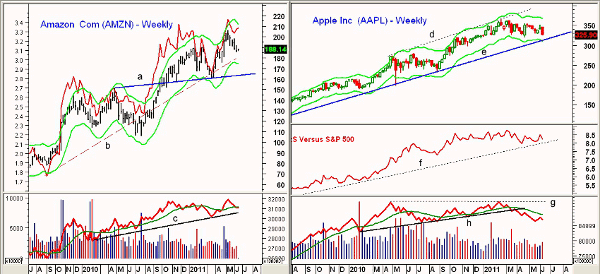The charts show that several of the tech sector’s big names have more room to fall before reaching technically oversold levels. Two in particular may begin to lag the S&P 500.
Last week’s 3.1% drop in the Nasdaq 100 left the index up by just 0.1% for the year. The weekly studies for the Nasdaq 100 are negative, but the majority of stocks did make new highs in early May. This still suggests that we are seeing a correction, and not the start of a new bear market.
The Nasdaq 100 closed just 1.3% above the weekly Starc- band, which is at 2191. This suggests that it is likely to stabilize—if not rebound—over the next week or so. The Nasdaq 100 index last exceeded its weekly Starc- band on March 16.
By analyzing all the stocks in the Nasdaq 100, only three are within 2% of the weekly Starc- bands. Those are Paychex, Inc. (PAYX), Microchip Technology, Inc. (MCHP), and Expeditors International Washington (EXPD).
Some of the tech sector’s biggest names, including NetFlix Inc. (NFLX), Google (GOOG), Amazon.com (AMZN), and Apple (AAPL) are still well above their weekly Starc- bands. This means that they are not yet oversold on a weekly basis. More importantly, the weekly technical readings for two of these tech giants have deteriorated, suggesting that they may now start to lag the S&P 500.
Chart Analysis: NetFlix Inc. (NFLX) has traded up to $276-$277 over the past two weeks, which was within 3.6% of the weekly Starc+ band, although the stock closed Friday (June 10) at $258.62.
- This is still well above the weekly chart support from the past two months at $223 and the uptrend (line a). The weekly Starc- band is at $215.35
- The relative performance, or RS analysis, is still in a very strong uptrend (line b) that goes back to early 2010. Since the end of 2009, NFLX is up 370% versus 13.9% for the S&P 500
- The weekly on-balance volume (OBV) is still holding above support, line d, but did form a short-term divergence at the recent highs (line c). A drop below the May lows will confirm the divergence and indicate a deeper pullback
- There is resistance for NFLX at $266-$277 with the weekly Starc+ band at $290.88. The midpoint in the weekly Starc bands is at $247
Google (GOOG) shows a much different RS pattern, as in 2011, it is down 14.1% while the S&P 500 is up 0.98%. The weekly support going back to 2008, line 3, was tested in April, but it has now been decisively broken.
- There is next support for GOOG in the $500 area with the weekly Starc- band at $480.39, or 5.7% below last Friday’s close
- The RS formed lower highs in 2010, indicating that it was no longer acting stronger than the S&P 500. The break of support at line g now creates a pattern of lower highs and lower lows
- The weekly OBV broke its uptrend in early 2011, line h, and is well below its declining weighted moving average (WMA), which is negative
- There is a minor resistance at $515-$520 with stronger resistance at $530-$533 and the daily Starc+ band
NEXT: More Tech Giants with Room to Fall
|pagebreak|Amazon.com (AMZN) peaked at $206.39 in early May and is down 9.6% from the highs after closing on Friday at $186.53. The weekly Starc- band is now at $174.80.
- There is important weekly chart support, line a, at $169.70
- The RS analysis still looks positive, as it is in a strong uptrend, line b. The RS made new highs in May
- The weekly OBV confirmed the recent highs and closed last week just below its weighted moving average. It is still above longer-term support at line c
- There is initial resistance in the $194-$200 area with the weekly Starc+ band at $214.45. AMZN is now trading below the midpoint of the Starc bands at $194
Apple (AAPL) is getting closer to the lower boundary of its 2011 trading range with Friday’s close at $325.80. The 2011 lows are at $320.16. The weekly Starc- band and the long-term uptrend, line e, are both now at $314. AAPL is very close to the daily Starc- band.
- The RS confirmed the highs in February, but it is quite close to its uptrend, line f. A drop below last September’s lows would indicate it had given up leadership
- The weekly OBV failed to make new highs in 2011, thereby forming a negative divergence, line g
- The drop below OBV support at line h is negative. A drop in the OBV below last summer’s lows would confirm the divergence and suggest that AAPL has formed an intermediate-term top
- There is initial resistance at $335 with much stronger resistance in the $350-$355 area
What It Means: The Starc bands are one tool I use to determine high- and low-risk times to buy or sell. (For more on Starc bands, see “Gain an Edge with Volatility Analysis.”)
While the Nasdaq 100 is getting closer to its weekly Starc- band, these four widely followed tech stocks are not as oversold. Their respective technical outlooks are also quite different, as only NetFlix Inc. (NFLX) and Amazon.com (AMZN) continue to look positive on an intermediate-term basis.
The negative outlook for Google (GOOG) and Apple (AAPL) was discussed on April 13, and GOOG has now reached more important chart support. After an oversold bounce in the next week or so, GOOG is likely to move lower. There has also been technical deterioration in AAPL, so its next rally will need to be watched closely as well.
How to Profit: For Amazon.com (AMZN), traders could look to buy at $183.04 with a stop at $174.66 (risk of approx. 4.6%). Sell half the position at $199.60 and raise the stop to $182.60.
For NetFlix Inc. (NFLX), traders should buy at $252.44 with a stop at $239.30 (risk of approx. 5.2%). Sell half the position at $275.80 and raise the stop to $249.40.
No recommendations for Google (GOOG) or Apple (AAPL) at this time.




















